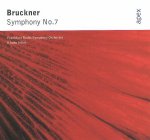Eliahu Inbal uses the 1954 Nowak score for this recording (originally released by Teldec) of Bruckner’s Seventh. The performance often impresses for the clarity and logic of Inbal’s direction. What you don’t get, though, is the richness of detail and sonic presence that the best versions afford. Compare the opening with that of Karajan’s 1989 DG Vienna recording: The tremolando violins seem too loud and the cellos’ entry at bar 3 is not only too loud, but as the theme unfolds, precisely-notated dynamic fluctuations also fail to register fully.
But Inbal makes an effectively abrupt shift into the faster-moving second theme, later building a finely controlled crescendo at the close of the movement. Karajan’s last DG recording highlights more inner texture, including second violin and viola interplay, bassoon lines, and lower brass pedal points. Inbal’s Adagio is sensitively drawn (with no cymbal crash at the climax) but there are several off-stage noises audible during the solemn coda for the Wagner tubas.
The finale is again well judged, but the recording doesn’t allow several key details of scoring to register as well as they should. These mostly concern the final E major peroration. Though it may seem unimportant on paper, bass tuba and bass trombone drop down the octave 13 measures from the end. It’s hardly audible here, but it should signal the start of the final crescendo. Karajan makes a point of it, as do Celibidache (in his EMI Munich account) and Georg Tintner (Naxos). Still, especially if price is your primary concern, Inbal remains a contender in a sparsely populated field of budget Bruckner Sevenths.
































